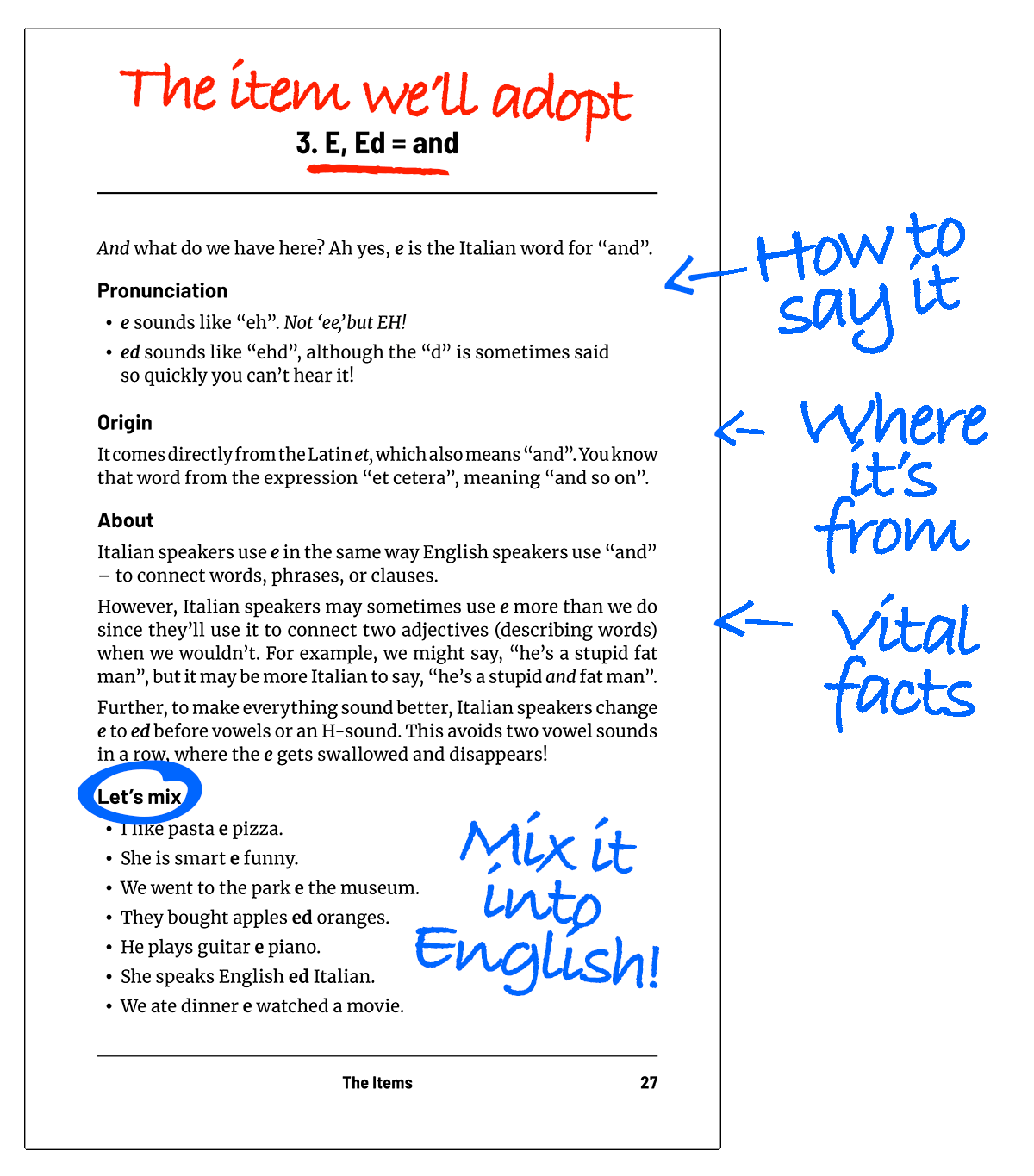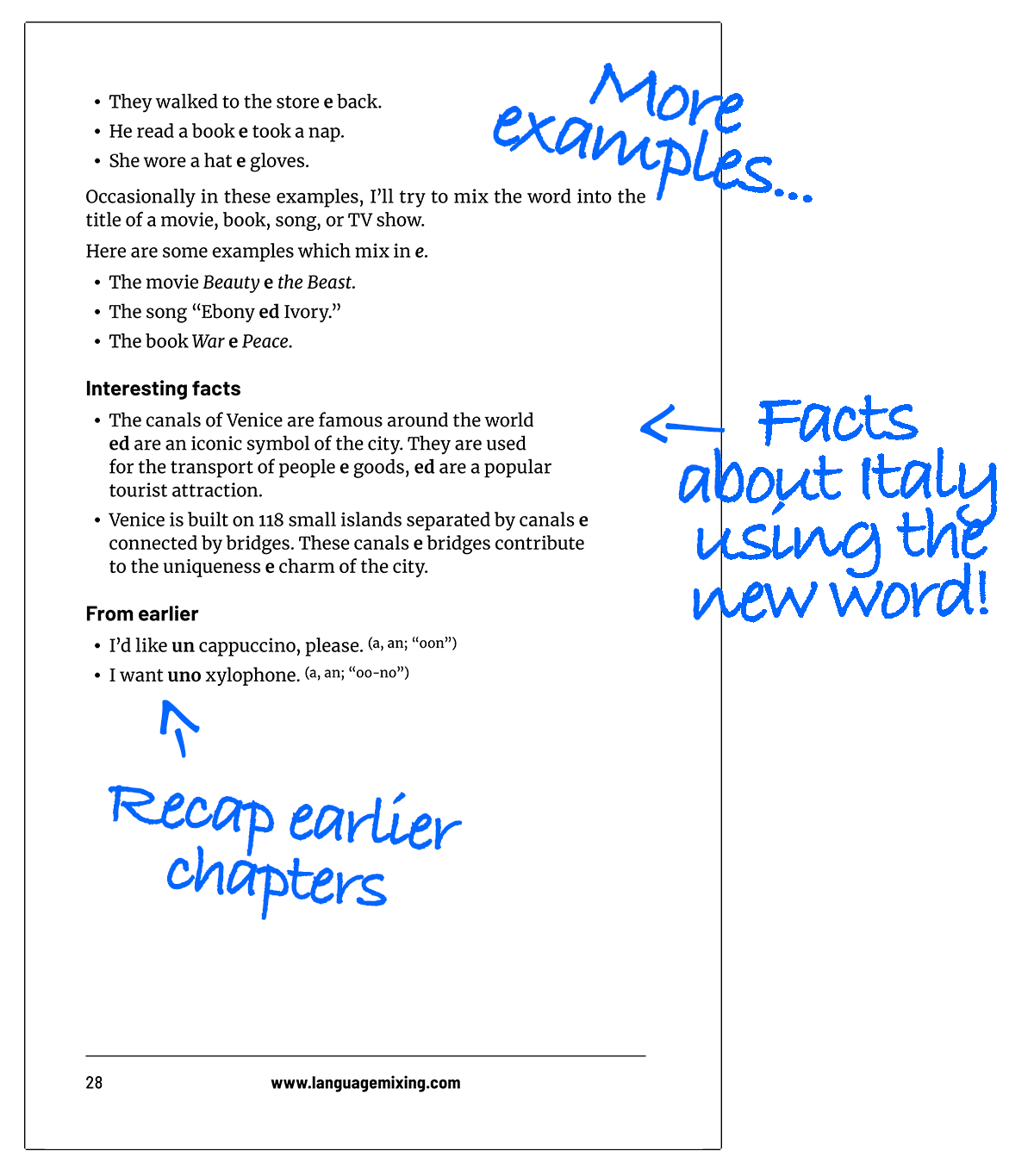emergency_home
Language learning has problems!

- query_statsA leaker from a major publisher revealed that 0% of customers finished reading their language books.
- thumb_downOne study found that 1/3 of language teaching methods didn’t work, and 1/3 made no difference!
- hourglass_bottomMost people forget everything, or nearly everything, they learn from language books and classes.
So what’s the solution?
elderly
A long-forgotten method

Back in 1968, a researcher from the University of Michigan proposed an “outlandish” method for language learning...
His new method appeared to work better than the usual ones.
But nobody cared.
Let me tell you what it was...
person_play
Pretend that Italian words are English!

qua
“Come qua to see the view.”
qua = here

su
“They’re strolling su the beach.”
su = on/upon

là
“Let’s go là to eat ice cream.”
là = there
post_add
Mix Italian words into interesting facts

ma
The Colosseum was used for gladiator shows, ma with the Empire’s decline, it underwent various uses.
ma = but

un’
Un’excursion along the Amalfi Coast reveals un’incredible variety of landscapes.
un’ = a / an (before a vowel)

che
Chianti is a region che boasts a long history of wine making. It’s believed che they first planted grapes 2,000 years ago.
che = that
extension
We’ve done it for centuries!

The majority of our English lexicon consists of foreign words that our ancestors gradually amalgamated into their current verbiage.
record_voice_over
English is mostly “foreign” words
About 70% of English words are ‘borrowed’ from other languages:
verified
Start with the most common words
What most language courses teach:
Hello, Thank you, Please, Yes, No, Good morning, Good night, Goodbye
The most common (and useful) words in real life:
- a
- and
- he
- I
- in
- is
- it
- my
- of
- that
- the
- then
- to
- was
- went
- with
psychology
We remember rarely-used English words

How often do most people use...
- Labyrinth?
- Whimsical?
- Quandary?
Rarely! Yet we remember them!
It’s always easier to remember words in your native language. But even simple Italian is hard to recall when learned as “foreign” words.
psychology
We learn new English words all the time!

The Oxford English Dictionary now adds new words four times a year; in March 2015 alone 500 new definitions were added, including 207 completely new words.
Over the past century, English has adopted:
- karate from Japanese
- parkour from French
- robot from Czech
- glitch from Yiddish
...we could go on and on.
timer
We only have so much time...
One language course I bought started off teaching words for things like dishwasher and paper towels...

Does that make sense to you?
What about ‘and’ or ‘with’?
incomplete_circle
We don’t need many words!
One study examined the text of hundreds of popular English-language books. They contained 850,000 different words, BUT...
...just 100 words covered 53% of the text!
Note: Such studies count all the different spellings (inflections) of a word as one. For example, “walk”, “walks”, “walked”, and “walking” would be counted as one word. But the point remains valid.
Source:
“Real books vs reading schemes: a new perspective from instructional psychology” by Jonathan Solity and Janet Vousden, Educational Psychology, 29:4, 469-511, doi: 10.1080/01443410903103657. This reference does not imply endorsement.
co_present
Many language teaching methods don’t work!

One study looked at different methods used to teach French.
It found that:
- arrow_circle_right About 1/3 of the methods had no effect.
- arrow_circle_right Another 1/3 actually harmed the students’ test scores.
- arrow_circle_right Of the ones that worked, their effectiveness varied depending on how often they were used.
To this day, few teachers even know about this research.
Source: “Reflections on Good and Bad teaching behaviours” by Robert L. Polizer, Language Learning, June 1970. doi:10.1111/j.1467-1770.1970.tb00043.x This reference does not imply endorsement.
science
Experiment results
In the Middle East

In 2014, researchers tested the same method I use in my books with Persian-speaking high school students trying to learn English. What happened?
Students using the new method scored almost doubled their score on a test!
Yes, on a test scoring out of 25, students using the method I promote scored 23 out of 25, whereas normal students only scored 12 out of 25.
In China

Researchers have reported its use in some Chinese kindergartens. Teachers use the method to make “sandwich stories” for teaching English. They mix English words into Chinese versions of classic children’s stories, such as Little Red Riding Hood.
Parents prefer the kindergartens using the method because their children speak English far more quickly.
Sources:
“The Effect of Teaching Vocabulary through the Diglot-Weave Technique on Vocabulary Learning of Iranian High School Students” by Azadeh Nemati (Islamic Azad University) and Ensieh Maleki (Payame-Nour University). Procedia - Social and Behavioral Sciences 98 (2014) 1340 – 1345. doi:10.1016/j.sbspro.2014.03.551 This reference does not imply endorsement.
“Communicative Language-Teaching through Sandwich Stories” by Yuhua Ji. TESL Canada Journal / Revue TESL du Canada Vol. 17 (Winter 1999) 103-113. doi:10.1017/S0266078402001049 This reference does not imply endorsement.
block
No more linguistic jargon!

Some “beginner” books will say “indicative present subjunctive” – with no explanation!
That’s why my books use my own simpler terms that everyone can understand.
| Official terms | = | My terms |
|---|---|---|
| conjuction | = | connecting word |
| suffix | = | word ending |
| present participle | = | -ing word (for descriptions) |
| gerund | = | -ing word (for actions) |
| definite article | = | “the” |
| indefinite article | = | “a” |
comment
Yes, it works with grammar
Compare how we teach the Italian ‑ato/‑uto/‑ito word endings...
How it’s often taught:
“The Italian past participle forms vary based on the verb endings of the infinitive form. They are ‑ato, ‑uto, and ‑ito; they are used for each of the three conjugation verb groups (‑are, ‑ere, ‑ire) respectively.
“Additionally, the spellings must change to match gender and number. For example, for the ‑are conjugation group, ‑ato/‑ata are used for singular masculine and feminine subjects respectively, while ‑ati/‑ate are used for plurals.
“This is not to be confused with the imperfect or past historic tenses.”
How my books teach it:
In English, we add the word ending “‑ed” on to words to say things like:
- “I have walked home”, or
- “We have talked about it”.
Well, Italian speakers instead add the word endings ‑ato, ‑uto, or ‑ito:
- I have washato the dishes.
- They have receiveuto a package.
- She has finishito reading the book.
We shall adopt these endings into English.
There are other ways to put things in the past, but we’ll adopt them later.
book
My books for Italian
Each book teaches the most useful words for a particular part of the Italian language. They’re designed to be short and easy to read.
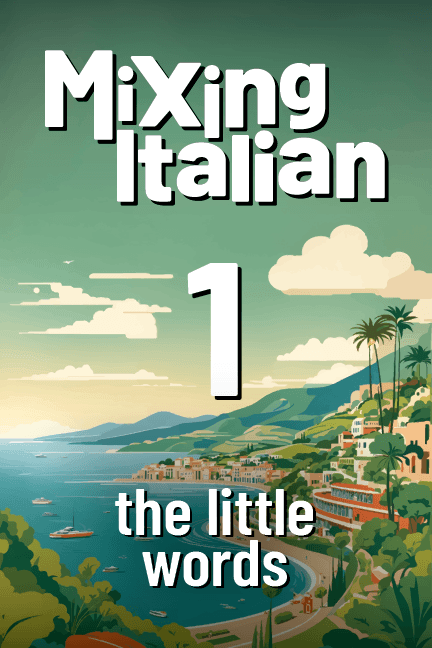

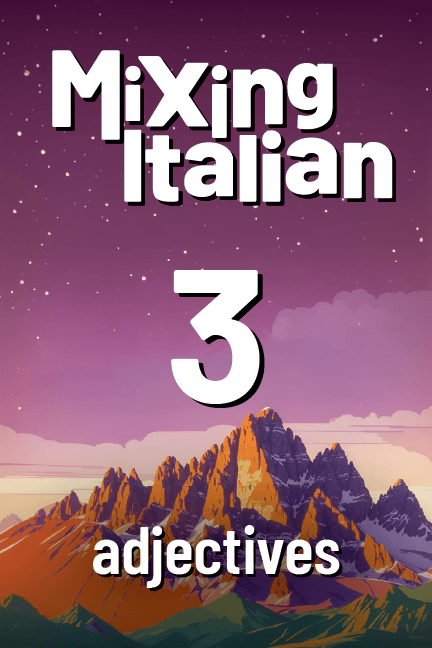

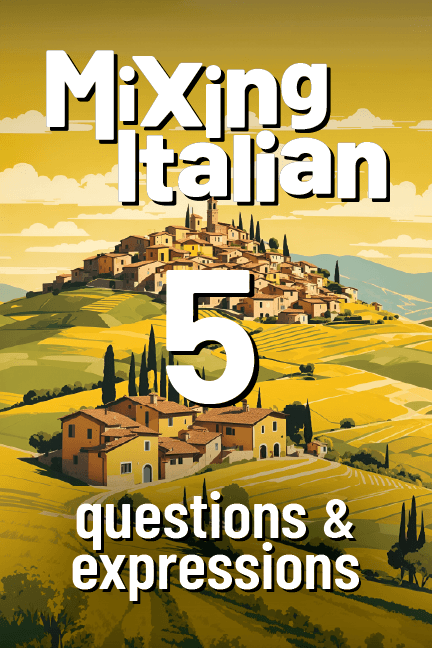
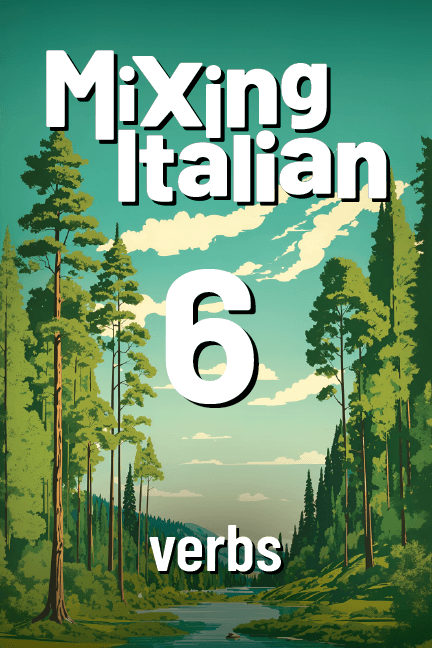
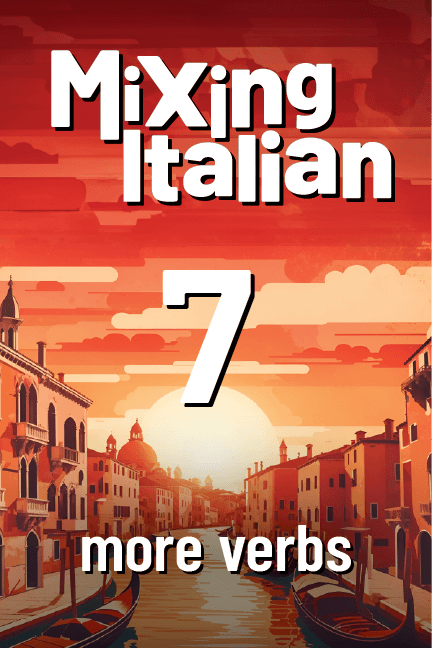
Here’s the first one:
This book mixes the following Italian into English...
| # | Italian | Example |
|---|---|---|
| 1 | un = a/an (masc.) | “I'd like un cappuccino, please.” |
| 2 | uno = a/an (special) | “I want uno xylophone.” |
| 3 | e/ed = and | “I like pasta e pizza.” |
| 4 | ma = but | “I'm tired, ma I need to study.” |
| 5 | una = a/an (fem.) | “I would like una pizza.” |
| 6 | un' = a/an (before vowel) | “I would like un'orange, please.” |
| 7 | o = or | “Do you want tea o coffee?” |
| 8 | perché = because | “I can't go out perché it's raining.” |
| 9 | l’ = the (before vowel) | “L’Italian opera is world-famous.” |
| 10 | ‘the’ is used more often | “The Italy is beautiful.” |
| 11 | con = with | “I'm going to the movies con my friends.” |
| 12 | qua = here | “Come qua to see the view.” |
| 13 | là = there | “Let's go là to eat an ice cream.” |
| 14 | per = for/to | “I study Italian per three hours a day.” |
| 15 | quindi = so/therefore | “I don't have money, quindi I can't buy pizza.” |
| 16 | il = the (masc.) | “Il Colosseum is in Rome.” |
| 17 | lo = the (special) | “Lo zoo is really fun.” |
| 18 | se = if | “I'll go to the beach se the weather is nice.” |
| 19 | né = neither, nor | “I like né coffee né tea.” |
| 20 | tuttavia = however | “I'm not hungry; tuttavia, I'll eat chocolate.” |
| 21 | dunque = so/therefore | “I didn't study, dunque I don't know the answer.” |
| 22 | i = the (masc. plural) | “I museums in Italy are famous.” |
| 23 | gli = the (masc. plural before vowels) | “Gli spaghetti is tasty.” |
| 24 | poiché = since, as | “I'm coming poiché you invited me.” |
| 25 | nonostante = despite, in spite of | “Nonostante the rain, we went out.” |
| 26 | la = the (fem.) | “I ate la pizza.” |
| 27 | le = the (fem. plural) | “Le girls have arrived.” |
| 28 | affinché = so that | “Study affinché you can pass the exam.” |
| 29 | benché = even though | “Benché it's late, we keep talking.” |
| 30 | pure = although | “Pure he feels tired, he keeps working.” |
| 31 | su = on/upon | “I like walking su this beach.” |
| 32 | a = to/at | “I'm going a school.” |
| 33 | in = in/at | “I live in a house and work n’office.” |
| 34 | di = from/of (possession) | “The recipe di my mother is originally di a book; it’s a work d’art!” |
| 35 | dai = from/of (characteristic) | “The girl dai brown hair comes da Milan.” |
| 36 | che = that | “I think che he is tired.” |
redeem
Choose your book
Free for Kindle Unlimited subscribers
Read them all for no extra charge with a Kindle Unlimited subscription. New customers can get a free trial. All books may also be purchased as normal.
Mixing Italian 1: The Little Words
Mixes the most common connecting words (conjunctions and prepositions) into English sentences, including the Italian for:
- and
- with
- or
- etc.
verifiedRecommended – start with this one!
Mixing Italian 2: Nouns
Mixes the most common nouns (names of things) into English sentences, including the Italian for:
- man
- woman
- house
- etc.
Mixing Italian 3: Adjectives
Mixes the most common adjectives (describing words) into English sentences, including the Italian for:
- large
- small
- new
- etc.
Mixing Italian 4: Me, You, & Others
Mixes the most common pronouns (words referring to people or things) into English sentences, including the Italian for:
- we
- us
- them
- etc.
Mixing Italian 5: Questions & Expressions
Mixes the most common question words and expressions into English sentences, including the Italian for:
- where?
- when?
- hello!
- etc.
Mixing Italian 6: Verbs
Mixes the most common verb endings into English sentences, including the Italian versions of:
- -ing endings
- -ed endings
- etc.
Mixing Italian 7: More Verbs
Mixes the most common verbs into English sentences, including the Italian for:
- eat
- go
- want
- etc.
Free samples
Amazon allows you to download generous free samples of all my books.
Mailing List
Get notified of new releases, and other interesting tidbits.
Unsubscribe at any time.
See previous e-mails.
